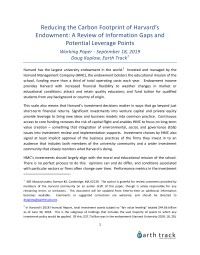Reducing the Carbon Footprint of Harvard’s Endowment: A Review of Information Gaps and Potential Leverage Points

This working paper identifies some of the major gaps in Harvard’s existing reporting on the climate impacts of its endowment; potential leverage points to address these gaps; and some next steps to develop solutions that protect investment flexibility for Harvard Management Company while greatly and rapidly improving transparency. These improvements are needed. Harvard has already signed on to responsible and sustainable investment programs including at least the United Nations Principles for Responsible Investment (PRI), the CDP (formerly Carbon Disclosure Project) climate change program, the Ceres Investor Network, the Intentional Endowment Network, and Climate Action 100+. And yet, the University has not released any significant information demonstrating that these ESG principles are being followed throughout its investment portfolio. At present, oversight of ESG issues within the Harvard endowment is unverifiable and weak. Little information on specific investments is made public, and statements regarding HMC’s integration of environmental concerns are qualitative and imprecise. Only with control systems that facilitate robust and independent external review can Harvard students, faculty, and alumni have confidence that HMC’s investment process will yield outcomes aligned with the school’s stated goals on climate change.
It is promising that the need to go well beyond written commitments is something that HMC staff also acknowledge. And further, that the University appears interested in, and committed to, improving and expanding what Harvard does to address climate change. A recent column by Harvard President Larry Bacow published in Harvard magazine (2019) on this topic stated that the school would be “a willing partner and active convener in the search for solutions.”
Better public data on Harvard’s endowment is an easy place to start. The immediate task is to identify practice and disclosure improvements that also protect Harvard Management Company’s flexibility and competitive advantage to identify and act quickly on investment opportunities. The paper presents a number of steps to make this happen.

